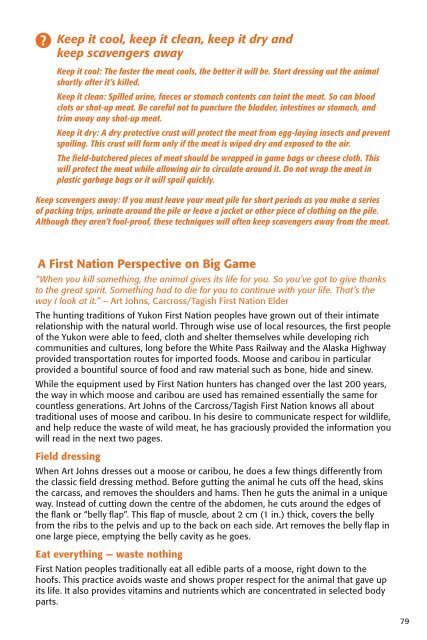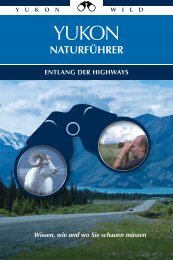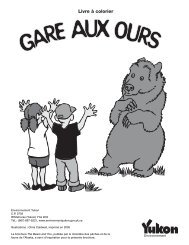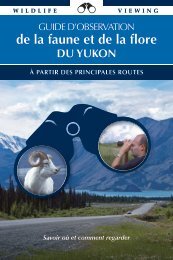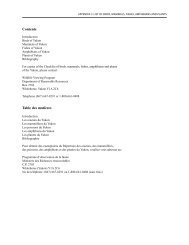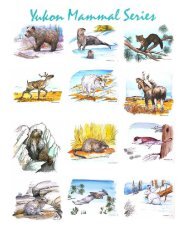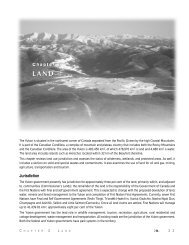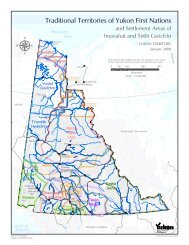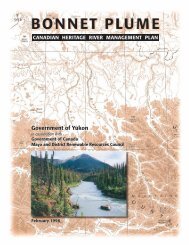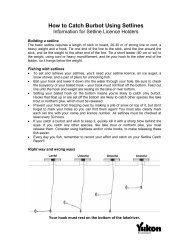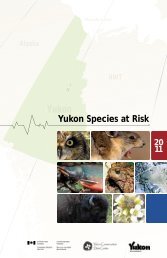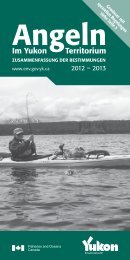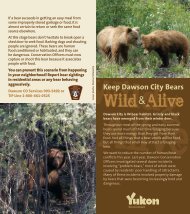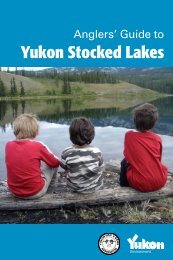Yukon Hunting - Department of Environment - Government of Yukon
Yukon Hunting - Department of Environment - Government of Yukon
Yukon Hunting - Department of Environment - Government of Yukon
Create successful ePaper yourself
Turn your PDF publications into a flip-book with our unique Google optimized e-Paper software.
Keep it cool, keep it clean, keep it dry and<br />
keep scavengers away<br />
Keep it cool: The faster the meat cools, the better it will be. Start dressing out the animal<br />
shortly after it’s killed.<br />
Keep it clean: Spilled urine, faeces or stomach contents can taint the meat. So can blood<br />
clots or shot-up meat. Be careful not to puncture the bladder, intestines or stomach, and<br />
trim away any shot-up meat.<br />
Keep it dry: A dry protective crust will protect the meat from egg-laying insects and prevent<br />
spoiling. This crust will form only if the meat is wiped dry and exposed to the air.<br />
The field-butchered pieces <strong>of</strong> meat should be wrapped in game bags or cheese cloth. This<br />
will protect the meat while allowing air to circulate around it. Do not wrap the meat in<br />
plastic garbage bags or it will spoil quickly.<br />
Keep scavengers away: If you must leave your meat pile for short periods as you make a series<br />
<strong>of</strong> packing trips, urinate around the pile or leave a jacket or other piece <strong>of</strong> clothing on the pile.<br />
Although they aren’t fool-pro<strong>of</strong>, these techniques will <strong>of</strong>ten keep scavengers away from the meat.<br />
A First Nation Perspective on Big Game<br />
“When you kill something, the animal gives its life for you. So you’ve got to give thanks<br />
to the great spirit. Something had to die for you to continue with your life. That’s the<br />
way I look at it.” – Art Johns, Carcross/Tagish First Nation Elder<br />
The hunting traditions <strong>of</strong> <strong>Yukon</strong> First Nation peoples have grown out <strong>of</strong> their intimate<br />
relationship with the natural world. Through wise use <strong>of</strong> local resources, the first people<br />
<strong>of</strong> the <strong>Yukon</strong> were able to feed, cloth and shelter themselves while developing rich<br />
communities and cultures, long before the White Pass Railway and the Alaska Highway<br />
provided transportation routes for imported foods. Moose and caribou in particular<br />
provided a bountiful source <strong>of</strong> food and raw material such as bone, hide and sinew.<br />
While the equipment used by First Nation hunters has changed over the last 200 years,<br />
the way in which moose and caribou are used has remained essentially the same for<br />
countless generations. Art Johns <strong>of</strong> the Carcross/Tagish First Nation knows all about<br />
traditional uses <strong>of</strong> moose and caribou. In his desire to communicate respect for wildlife,<br />
and help reduce the waste <strong>of</strong> wild meat, he has graciously provided the information you<br />
will read in the next two pages.<br />
Field dressing<br />
When Art Johns dresses out a moose or caribou, he does a few things differently from<br />
the classic field dressing method. Before gutting the animal he cuts <strong>of</strong>f the head, skins<br />
the carcass, and removes the shoulders and hams. Then he guts the animal in a unique<br />
way. Instead <strong>of</strong> cutting down the centre <strong>of</strong> the abdomen, he cuts around the edges <strong>of</strong><br />
the flank or “belly flap”. This flap <strong>of</strong> muscle, about 2 cm (1 in.) thick, covers the belly<br />
from the ribs to the pelvis and up to the back on each side. Art removes the belly flap in<br />
one large piece, emptying the belly cavity as he goes.<br />
Eat everything — waste nothing<br />
First Nation peoples traditionally eat all edible parts <strong>of</strong> a moose, right down to the<br />
ho<strong>of</strong>s. This practice avoids waste and shows proper respect for the animal that gave up<br />
its life. It also provides vitamins and nutrients which are concentrated in selected body<br />
parts.<br />
79


